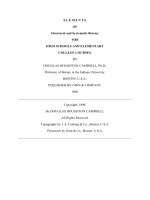ELEMENTS OF X-RAY DIFFRACTION ppt
Bạn đang xem bản rút gọn của tài liệu. Xem và tải ngay bản đầy đủ của tài liệu tại đây (33.01 MB, 524 trang )
ADDISON-WESLEY
METALLURGY
SERIES
MORRIS
COHEN,
Consulting
Editor
Cidlity
ELEMENTS
OF
X-RAY
DIFFRACTION
Guy
ELEMENTS
OF
PHYSICAL
METALLURGY
Norton
ELEMENTS OF
CERAMICS
Schuhmann
METALLURGICAL ENGINEERING
VOL. I:
ENGINEERING
PRINCIPLES
Wagner
THERMODYNAMICS
OF
ALLOYS
ELEMENTS
OF
X-RAY
DIFFRACTION
by
B.
D.
CULLITY
Associate
Professor of
Metallurgy
University of
Notre Dame
ADDISON-WESLEY
PUBLISHING
COMPANY,
INC.
READING,
MASSACHUSETTS
Copyright
1956
ADD1SON-WESLEY PUBLISHING
COMPANY,
Inc.
Printed
ni
the
United
States
of
America
ALL
RIGHTS RESERVED.
THIS
BOOK,
OR
PARTS THERE-
OF,
MAY NOT BE
REI'RODl
CED
IN ANY
FORM WITHOUT
WRITTEN
PERMISSION OF
THE
PUBLISHERS
Library
of Congress
Catalog
No 56-10137
PREFACE
X-ray
diffraction
is a
tool for the
investigation
of the
fine
structure
of
matter.
This
technique
had its
beginnings
in
von Laue's
discovery
in
1912
that
crystals
diffract
x-rays,
the
manner
of
the diffraction
revealing
the
structure
of the
crystal.
At
first,
x-ray
diffraction
was
used
only
for
the
determination
of
crystal
structure. Later
on,
however,
other
uses were
developed,
and
today
the method
is
applied,
not
only
to
structure
deter-
mination,
but to
such diverse
problems
as
chemical
analysis
and
stress
measurement,
to the
study
of
phase
equilibria
and
the
measurement of
particle
size,
to
the determination
of
the
orientation
of
one
crystal
or
the
ensemble
of
orientations
in
a
polycrystalline
aggregate.
The
purpose
of
this
book
is
to
acquaint
the
reader who
has
no
previous
knowledge
of
the
subject
with the
theory
of
x-ray diffraction,
the
experi-
mental
methods
involved,
and the main
applications.
Because the
author
is a
metallurgist,
the
majority
of these
applications
are
described
in
terms
of
metals
and
alloys.
However,
little or no
modification
of
experimental
method
is
required
for the
examinatiorrof nonmetallic
materials,
inasmuch
as the
physical
principles
involved
do not
depend
on the material
investi-
gated.
This
book
should therefore
be
useful
to
metallurgists, chemists,
physicists,
ceramists,
mineralogists,
etc.,
namely,
to all
who
use
x-ray
diffrac-
tion
purely
as a
laboratory
tool
for the
sort
of
problems
already
mentioned.
Members
of this
group,
unlike
x-ray
crystallographers,
are
not
normally
concerned
with
the
determination of
complex
crystal
structures. For this
reason
the
rotating-crystal
method
and
space-group
theory,
the two chief
tools
in
the solution of
such
structures,
are described
only briefly.
This
is a book of
principles
and
methods intended
for
the
student,
and
not
a
reference
book for the advanced research worker.
Thus
no metal-
lurgical
data
are
given
beyond
those
necessary
to illustrate
the
diffraction
methods involved.
For
example,
the
theory
and
practice
of
determining
preferred
orientation
are treated
in
detail,
but
the
reasons for
preferred
orientation,
the
conditions
affecting
its
development,
and
actual
orien-
tations
found
in
specific
metals and
alloys
are
not
described,
because these
topics
are
adequately
covered
in
existing
books.
In
short, x-ray
diffrac-
tion
is
stressed
rather than
metallurgy.
The
book
is
divided into
three
main
parts:
fundamentals, experimental
methods,
and
applications.
The
subject
of
crystal
structure
is
approached
through,
and
based
on,
the
concept
of
the
point
lattice
(Bravais lattice),
because
the
point
lattice of
a
substance
is
so
closely
related
to its
diffrac-
VI
PREFACE
tion
pattern.
The
entire
book
is
written
in
terms
of the
Bragg
law and
can be read
without
any knowledge
of
the
reciprocal
lattice.
(However,
a
brief
treatment
of
reciprocal-lattice theory
is
given
in
an
appendix
for those
who
wish to
pursue
the
subject
further.)
The methods
of
calculating
the
intensities
of
diffracted beams are introduced
early
in
the book
and
used
throughout.
Since
a
rigorous
derivation
of
many
of
the
equations
for
dif-
fracted
intensity
is
too
lengthy
and
complex
a
matter
for
a
book
of
this
kind,
I
have
preferred
a
semiquantitative
approach
which,
although
it does
not furnish
a
rigorous
proof
of the
final
result,
at
least
makes
it
physically
reasonable.
This
preference
is
based
on
my
conviction that
it
is
better
for
a student
to
grasp
the
physical
reality
behind
a
mathematical
equation
than to
be able
to
glibly
reproduce
an involved mathematical
derivation
of
whose
physical meaning
he
is
only
dimly
aware.
Chapters
on chemical
analysis
by
diffraction and fluorescence
have been
included
because
of the
present
industrial
importance
of these
analytical
methods.
In
Chapter
7
the
diffractometer,
the newest
instrument
for
dif-
fraction
experiments,
is described
in
some
detail
;
here the material
on
the
various
kinds
of
counters
and their associated
circuits should be
useful,
not
only
to those
engaged
in
diffraction
work,
but
also to those
working
with radioactive
tracers
or
similar
substances
who
wish to know
how their
measuring
instruments
operate.
Each
chapter
includes
a
set
of
problems.
Many
of these
have
been
chosen
to
amplify
and extend
particular
topics
discussed
in
the
text,
and
as
such
they
form
an
integral
part
of
the book.
Chapter
18 contains
an
annotated
list of books
suitable
for further
study.
The reader
should
become
familiar
with at
least
a few
of
these,
as
he
pro-
gresses
through
this
book,
in
order
that he
may
know
where
to
turn
for
additional information.
Like
any
author of a technical
book,
I
am
greatly
indebted
to
previous
writers on this
and
allied
subjects.
I
must
also
acknowledge
my gratitude
to two of
my
former teachers
at
the
Massachusetts
Institute of
Technology,
Professor
B.
E.
Warren
and Professor
John
T.
Norton:
they
will
find
many
an
echo of their
own
lectures
in
these
pages.
Professor
Warren
has
kindly
allowed me to use
many problems
of
his
devising,
and
the
advice
and
encouragement
of Professor Norton
has
been
invaluable.
My
colleague
at
Notre
Dame,
Professor
G. C.
Kuczynski,
has
read
the entire
book
as
it
was
written,
and his
constructive
criticisms have
been
most
helpful.
I
would
also
like to thank the
following,
each
of
whom
has
read
one or
more
chap-
ters and
offered valuable
suggestions:
Paul
A.
Beck,
Herbert
Friedman,
S. S.
Hsu,
Lawrence
Lee,
Walter C.
Miller,
William
Parrish,
Howard
Pickett,
and
Bernard
Waldman.
I
am
also indebted
to C.
G. Dunn
for
the loan
of illustrative
material
and
to
many graduate
students,
August
PREFACE
Vll
Freda
in
particular,
who have
helped
with
the
preparation
of
diffraction
patterns.
Finally
but
not
perfunctorily,
I
wish
to thank Miss
Rose Kunkle
for
her
patience
and
diligence
in
preparing
the
typed
manuscript.
B. D.
CULLITY
Notre
Dame,
Indiana
March,
1956
FUNDAMENTALS
CHAPTER
1
PROPERTIES
OF
X-RAYS
1
1-1
Introduction
1
1-2
Electromagnetic
radiation
1
1-3
The
continuous
spectrum
. 4
1-4
The
characteristic
spectrum
6
1-5
Absorption
.
10
1-6 Filters
16
1-7
Production of
x-rays
17
1 -8 Detection
of
x-rays
23
1
9
Safety
precautions
.
25
CHAPTER
2
THE
GEOMETRY
OF
CRYSTALS
29
^2-1
Introduction
.
29
J2-2
Lattices
.
29
2-3
Crystal systems
30
^2-4
Symmetry
34
2-5
Primitive
and
nonprimitive
cells
36
2-6
Lattice
directions
and
planes
*
. 37
2-7
Crystal
structure
J
42
2-8
Atom
sizes and
coordination
52
2-9
Crystal shape
54
2-10
Twinned
crystals
.
55
2-11 The
stereographic projection
.
. 60
CHAPTER 3
DIFFRACTION
I: THE DIRECTIONS
OF DIFFRACTED
BEAMS 78
3-1
Introduction
.
.78
3-2
Diffraction
f
.
79
^3-3
The
Bragg
law
*
'
.
84
3-4
X-ray spectroscopy
85
3-5
Diffraction
directions
-
88
3-6
Diffraction methods
. 89
3-7
Diffraction under
nonideal conditions
. 96
CHAPTER 4 DIFFRACTION
II:
THE
INTENSITIES OF
DIFFRACTED
BEAMS . 104
4-1
Introduction
104
4-2
Scattering
by
an
electrons
.
. 105
4-3
Scattering by
an
atom
>,
.
/
108
4-4
Scattering by
a unit cell
*/
.
Ill
CONTENTS
4-5
Some
useful
relations
.
118
4-6
Structure-factor
calculations
^
118
4-7
Application
to
powder
method
'
123
4-8
Multiplicity
factor
124
4-9
Lorentz
factor
124
1-10
Absorption
factor
129
4-11
Temperature
factor
130
4-12
Intensities
of
powder
pattern
lines
132
4-13
Examples
of
intensity
calculations
132
4-14
Measurement
of
x-ray
intensity
136
EXPERIMENTAL
METHODS
LPTER
5
LAUE
PHOTOGRAPHS
138
5-1
Introduction
138
5-2
Cameras
.
138
5-3
Specimen
holders
143
5-4
Collimators
.
.144
5-5
The
shapes
of Laue
spots
.
146
kPTER
6
POWDER
PHOTOGRAPHS
.
.149
6-1
Introduction
.
149
6-2
Debye-Scherrer
method
. 149
6-3
Specimen
preparation
153
6-4
Film
loading
.
.
154
6-5
Cameras
for
high
and
low
temperatures
.
156
6-6
Focusing
cameras
.
156
6-7
Seemann-Bohlin
camera
.
157
6-8
Back-reflection
focusing
cameras
.
.
.160
6-9
Pinhole
photographs
.
163
6-10
Choice
of
radiation
.
.165
6-11
Background
radiation
.
166
6-12
Crystal
monochromators
.
168
6-13
Measurement
of
line
position
173
6-14
Measurement
of
line
intensity
.
173
VPTER 7
DlFFRACTOMETER
MEASUREMENTS
177
7-1
Introduction
.
.
.
177
7-2 General
features
177
7-3
X-ray optics
.
.
.
-
184
7-4
Intensity
calculations
.
188
7-5
Proportional
counters
.
.
. .
190
7-6
Geiger
counters
.
.
.193
7-7
Scintillation counters
.
-
201
7-8
Sealers
.
.202
7-9
Ratemeters
.
-
206
7-10
Use
of
monochromators
211
CONTENTS
XI
APPLICATIONS
CHAPTER
8 ORIENTATION
OF
SINGLE
CRYSTALS
.
. .
215
8-1
Introduction
.
.
215
8-2
Back-reflection
Laue
method
.
. .215
8-3
Transmission
Laue
method
.
229
8-4
Diffractometer
method
'
.
237
8-5
Setting
a
crystal
in a
required
orientation
. 240
8-6
Effect
of
plastic
deformation
.
242
8-7
Relative
orientation
of
twinned
crystals
250
8-8
Relative
orientation
of
precipitate
and
matrix
.
.
.
256
CHAPTER
9
THE
STRUCTURE
OF
POLYCRYSTALLINE
AGGREGATES
.
259
9-1
Introduction
.
259
CRYSTAL
SIZE
9-2 Grain
size
259
9-3
Particle
size
.
261
CRYSTAL
PERFECTION
9-4
Crystal perfection
.
263
9-5
Depth
of
x-ray
penetration
. .
269
CRYSTAL
ORIENTATION
9-6
General
.
.272
9-7
Texture
of
wire
and
rod
(photographic
method)
. . . 276
9-8 Texture
of sheet
(photographic
method)
280
9-9 Texture
of
sheet
(diffractometer
method)
.
.
285
9-10
Summary
.
. 295
CHAPTER 10
THE DETERMINATION
OF
CRYSTAL
STRUCTURE
.
. . 297
10-1
Introduction
.
.
297
10-2
Preliminary
treatment
of data
.
.
. 299
10-3
Indexing
patterns
of
cubic
crystals
301
10-4
Indexing
patterns
of noncubic
crystals
(graphical
methods)
304
10-5
Indexing patterns
of
noncubic
crystals
(analytical
methods)
. .311
10-6
The effect
of
cell
distortion on
the
powder
pattern
. . . 314
10-7
Determination
of the number
of atoms
in
a unit
cell
.
.316
10-8
Determination
of atom
positions
.
317
10-9
Example
of structure determination
.
320
CHAPTER 11
PRECISE
PARAMETER MEASUREMENTS
.
324
11-1
Introduction
324
11-2
Debye-Scherrer
cameras
326
1
1-3
Back-reflection
focusing
cameras
333
11-4
Pinhole cameras
333
11-5
Diffractometers
334
11-6
Method of least
squares
.335
Xll
CONTENTS
11-7
Cohen's
method
338
11-8
Calibration
method
. .
342
CHAPTER
12
PHASE-DIAGRAM
DETERMINATION
.
.
.
345
12-1
Introduction
.
345
12-2
General
principles
. .
346
12-3
Solid
solutions
.
351
12-4
Determination
of
solvus curves
(disappearing-phase method)
354
12-5
Determination
of solvus curves
(parametric
method)
356
12-6
Ternary systems
359
CHAPTER
13 ORDER-DISORDER
TRANSFORMATIONS
363
13-1
Introduction
.
363
13-2
Long-range
order
in
AuCus
363
13-3
Other
examples
of
long-range
order 369
13-4
Detection
of
superlattice
lines
372
13-5
Short-range
order and
clustering
375
CHAPTER
14
CHEMICAL
ANALYSIS
BY DIFFRACTION
378
14-1 Introduction
378
QUALITATIVE
ANALYSIS
14-2
Basic
principles
379
14-3 Hanawait
method
379
14-4
Examples
of
qualitative
analysis
383
14-5 Practical
difficulties
386
14-6
Identification
of surface
deposits
387
QUANTITATIVE
ANALYSIS
(SINGLE PHASE)
14-7
Chemical
analysis by parameter
measurement
388
QUANTITATIVE
ANALYSIS
(MULTIPHASE)
14-8 Basic
principles
. .
.
388
14-9 Direct
comparison
method
.
.
. 391
14-10 Internal standard
method
. .
.
396
14-11
Practical difficulties
.
.
.
398
CHAPTER
15
CHEMICAL
ANALYSIS
BY
FLUORESCENCE
402
15-1
Introduction
.
402
15-2
General
principles
.
.
404
15-3
Spectrometers
.
407
15-4
Intensity
and
resolution
.
.
.
410
15-5
Counters
.
414
15-6
Qualitative
analysis
414
15-7
Quantitative
analysis
.
. 415
15-8
Automatic
spectrometers
.
.
417
15-9
Nondispersive analysis
.
419
15-10
Measurement of
coating
thickness
421
CONTENTS
xiil
CHAPTER
16 CHEMICAL
ANALYSIS
BY
ABSORPTION
.
.
.
423
16-1
Introduction
.
. .
423
16-2
Absorption-edge
method .
.
424
16-3
Direct-absorption
method
(monochromatic
beam)
.
427
16-4
Direct-absorption
method
(polychromatic beam)
429
16-5
Applications
.
.
429
CHAPTER 17
STRESS
MEASUREMENT
.
431
17-1 Introduction .
431
17-2
Applied
stress
and
residual
stress
. .
431
17-3 Uniaxial stress
.
.
434
17-4
Biaxial stress
.
436
17-5
Experimental technique (pinhole camera)
441
17-6
Experimental
technique
(diffractometer)
444
17-7
Superimposed
macrostress and
microstress
447
17-8
Calibration
449
1
7-9
Applications
451
CHAPTER
18
SUGGESTIONS
FOR FURTHER STUDY
.
454
18-1 Introduction
454
18-2 Textbooks
.
454
18-3 Reference
books
.
457
18-4
Periodicals
458
APPENDIXES
APPENDIX
1 LATTICE GEOMETRY . 459
Al-1 Plane
spacings
459
Al-2
Cell
volumes
.
.
460
Al-3
Interplanar
angles
. .
.
460
APPENDIX
2 THE
RHOMBOHEDRAL-HEXAGONAL
TRANSFORMATION 462
APPENDIX 3
WAVELENGTHS
(IN
ANGSTROMS)
OF SOME
CHARACTERISTIC
EMISSION
LINES
AND
ABSORPTION
EDGES .
.
. 464
APPENDIX
4 MASS
ABSORPTION COEFFICIENTS
AND DENSITIES
.
466
APPENDIX 5
VALUES
OF siN
2
8
. 469
APPENDIX
6
QUADRATIC
FORMS OF MILLER
INDICES
. .
.
471
APPENDIX 7 VALUES
OF
(SIN
0)/X
. .
.
472
APPENDIX
8
ATOMIC SCATTERING
FACTORS
. 474
APPENDIX
9
MULTIPLICITY
FACTORS
FOR POWDER PHOTOGRAPHS
.
*
.
477
APPENDIX
10 LORENTZ-POLARIZATION
FACTOR
478
APPENDIX 11
PHYSICAL
CONSTANTS
.
480
XIV
CONTENTS
APPENDIX
12 INTERNATIONAL ATOMIC
WEIGHTS,
1953
481
APPENDIX
13
CRYSTAL
STRUCTURE
DATA
482
APPENDIX
14
ELECTRON
AND
NEUTRON DIFFRACTION
486
A14-1
Introduction
.
.
. 486
A14r-2 Electron diffraction
.
486
A14-3 Neutron diffraction
.
487
APPENDIX
15 THE
RECIPROCAL
LATTICE
.
.
490
A15-1
Introduction .
.490
A15-2 Vector
multiplication
.
490
A15-3 The
reciprocal
lattice
.
.
491
A15-4
Diffraction and the
reciprocal
lattice .
496
A15-5 The
rotating-crystal
method
.
499
A15-6
The
powder
method .
500
A15-7 The
Laue method
. .
502
ANSWERS
TO
SELECTED
PROBLEMS .
506
INDEX
509
CHAPTER
1
PROPERTIES
OF
X-RAYS
1-1 Introduction.
X-rays
were discovered
in 1895
by
the German
physicist
Roentgen
and were
so
named
because
their
nature
was
unknown
at the
time.
Unlike
ordinary
light,
these
rays
were
invisible,
but
they
traveled
in
straight
lines
and
affected
photographic
film in
the
same
way
as
light.
On the other
hand,
they
were
much
more
penetrating
than
light
and could
easily
pass
through
the human
body,
wood,
quite
thick
pieces
of
metal,
and
other
"opaque"
objects.
It
is not
always
necessary
to understand
a
thing
in
order
to
use
it,
and
x-rays
were
almost
immediately
put
to
use
by physicians
and,
somewhat
later,
by
engineers,
who
wished
to
study
the internal
structure
of
opaque
objects.
By placing
a source
of
x-rays
on
one
side of
the
object
and
photo-
graphic
film on
the
other,
a
shadow
picture,
or
radiograph,
could
be
made,
the less
dense
portions
of the
object
allowing
a
greater
proportion
of the
x-radiation
to
pass
through
than
the
more
dense.
In
this
way
the
point
of fracture
in a broken
bone
or the
position
of a crack
in
a
metal
casting
could
be located.
Radiography
was
thus
initiated
without
any
precise
understanding
of
the
radiation
used,
because
it was
not until 1912
that
the exact
nature
of
x-rays
was established.
In
that
year
the
phenomenon
of
x-ray diffraction
by
crystals
was
discovered,
and
this
discovery
simultaneously proved
the
wave nature
of
x-rays
and
provided
a
new
method
for
investigating
the
fine
structure
of
matter.
Although
radiography
is a
very
important
tool
in
itself
and has
a wide
field
of
applicability,
it
is
ordinarily
limited
in the
internal
detail
it can
resolve,
or
disclose,
to
sizes
of
the
order
of
10""
1
cm.
Diffraction,
on the
other
hand,
can
indirectly
reveal
details
of
internal
structure
of the
order
of
10~~
8
cm
in
size,
and
it
is with
this
phenomenon,
and
its
applications
to
metallurgical
problems,
that this
book
is concerned.
The
properties
of
x-rays
and
the internal
structure
of
crystals
are here
described
in the
first
two
chapters
as
necessary
preliminaries
to
the
dis-
cussion of
the
diffraction
of
x-rays
by
crystals
which
follows.
1-2
Electromagnetic
radiation.
We
know
today
that
x-rays
are elec-
tromagnetic
radiation
of
exactly
the
same
nature
as
light
but
of
very
much
shorter
wavelength.
The
unit
of
measurement
in
the
x-ray
region
is the
angstrom
(A),
equal
to 10~
8
cm,
and
x-rays
used
in diffraction
have
wave-
lengths
lying
approximately
in
the
range
0.5-2.5A,
whereas
the
wavelength
of
visible
light
is
of
the
order
of 6000A.
X-rays
therefore
occupy
the
1
PROPERTIES
OF
X-RAYS
[CHAP.
1
1
megacycle
10_
1
kilocycle
IQl
FIG.
i-i.
The
electromagnetic
spectrum.
The
boundaries
between
regions
are
arbitrary,
since
no
sharp
upper
or lower
limits can
be
assigned.
(F.
W.
Sears,
Optics,
3rd
ed.,
Addison-
Wesley
Publishing
Company,
Inc.,
Cambridge,
Mass.,
1949
)
region
between
gamma
and
ultraviolet
rays
in
the
complete
electromag-
netic
spectrum
(Fig.
1-1).
Other
units
sometimes
used
to measure
x-ray
wavelength
are
the
X unit
(XU)
and
the
kilo
X unit
(kX
=
1000
XU).*
The
X
unit
is
only
slightly
larger
than the
angstrom,
the
exact
relation
bemg
lkX=
1.00202A.
It
is
worth
while
to review
briefly
some
properties
of
electromagnetic
waves.
Suppose
a monochromatic
beam
of
x-rays,
i.e.,
x-rays
of
a
single
wavelength,
is
traveling
in
the
x
direction
(Fig.
1-2).
Then
it has
asso-
ciated with it an electric
field
E
in,
say,
the
y
direction
and,
at
right
angles
to
this,
a
magnetic
field
H in the
z
direction.
If the electric
field
is con-
fined to
the
xy-plane
as the
wave
travels
along,
the
wave
is said
to
be
plane-
polarized.
(In
a
completely
unpolarized
wave,
the
electric
field vector
E
and hence
the
magnetic
field
vector
H
can assume
all
directions
in
the
*
For the
origin
of these
units,
see
Sec.
3-4.
1-2]
ELECTROMAGNETIC
RADIATION
FIG.
1-2.
Electric
and
magnetic
fields
associated
with
a wave
moving
in
the j-direction.
t/2-plane.)
The
magnetic
field
is
of
no
concern
to us here
and we need
not
consider
it
further.
In the
plane-polarized
wave
con-
sidered,
E
is
not
constant
with
time
but varies from a
maximum
in
the
+y
direction
through
zero
to
a maxi-
mum in the
y
direction
and
back
again,
at
any
particular
point
in
space, say
x
=
0.
At
any
instant
of
time,
say
t
=
0,
E
varies
in
the
same
fashion
with distance
along
thex-axis.
If
both
variations
are
assumed
to be
sinusoidal, they
may
be
expressed
in
the
one
equation
E
=
Asin27r(-
-
lA
(1-1)
where
A
=
amplitude
of
the
wave,
X
=
wavelength,
and
v
=
frequency.
The
variation
of
E is
not
necessarily
sinusoidal,
but
the exact
form
of
the
wave matters
little;
the
important
feature
is
its
periodicity.
Figure
1-3
shows
the variation
of E
graphically.
The
wavelength
and
frequency
are
connected
by
the relation
c
X
-
(1-2)
V
where
c
=
velocity
of
light
=
3.00
X
10
10
cm/sec.
Electromagnetic
radiation,
such
as
a
beam
of
x-rays,
carries
energy,
and
the rate
of
flow of
this
energy
through
unit
area
perpendicular
to
the
direc-
tion
of motion
of
the
wave
is
called
the
intensity
I. The
average
value
of
the
intensity
is
proportional
to
the
square
of the
amplitude
of
the
wave,
i.e.,
proportional
to
A
2
. In
absolute
units,
intensity
is
measured
in
ergs/cm
2
/sec,
but
this
measurement
is a
difficult
one
and is
seldom
carried
out;
most
x-ray
intensity
measurements
are
made
on
a
relative
basis
in
+E
-E
+E
i
(a)
(b)
FIG. 1-3.
The
variation
of
E,
(a)
with
t
at
a
fixed
value
of
x and
(b)
with
x
at
a
fixed
value
of t.
4
PKOPERTIES
OF
X-RAYS
[CHAP.
1
arbitrary
units,
such
as the
degree
of
blackening
of a
photographic
film
exposed
to
the
x-ray
beam.
An accelerated
electric
charge
radiates
energy.
The acceleration
may,
of
course,
be
either
positive
or
negative,
and
thus
a
charge
continuously
oscillating
about
some
mean
position
acts
as
an
excellent
source
of electro-
magnetic
radiation.
Radio
waves,
for
example,
are
produced
by
the oscil-
lation
of
charge
back
and
forth
in
the
broadcasting
antenna,
and visible
light
by
oscillating
electrons
in the
atoms
of
the substance
emitting
the
light.
In
each
case,
the
frequency
of
the radiation
is
the
same
as
the fre-
quency
of
the oscillator
which
produces
it.
Up
to
now
we
have
been
considering
electromagnetic
radiation
as wave
motion
in
accordance
with
classical
theory.
According
to the
quantum
theory,
however,
electromagnetic
radiation
can
also
be
considered
as a
stream
of
particles
called
quanta
or
photons.
Each
photon
has associated
with
it an
amount
of
energy
hv,
where
h
is Planck's
constant
(6.62
X
10~
27
erg
-sec).
A
link
is
thus
provided
between
the
two
viewpoints,
because
we
can
use the
frequency
of the
wave
motion
to calculate
the
energy
of
the
photon.
Radiation
thus
has
a
dual
wave-particle
character,
and
we
will
use
sometimes
one
concept,
sometimes
the
other,
to
explain
various
phenomena,
giving
preference
in
general
to
the
classical
wave
theory
when-
ever
it
is
applicable.
1-3
The
continuous
spectrum.
X-rays
are
produced
when
any
electri-
cally
charged
particle
of sufficient
kinetic
energy
is
rapidly
decelerated.
Electrons
are
usually
used
for this
purpose,
the
radiation
being
produced
in
an
x-ray
tube
which
contains
a source
of
electrons
and
two
metal
elec-
trodes.
The
high
voltage
maintained
across
these
electrodes,
some
tens
of thousands
of
volts,
rapidly
draws
the
electrons
to the
anode,
or
target,
which
they
strike
with
very
high
velocity.
X-rays
are
produced
at
the
point
of
impact
and
radiate
in
all
directions.
If e
is the
charge
on the
elec-
tron
(4.80
X
10~
10
esu)
and
1) the
voltage
(in
esu)*
across
the
electrodes,
then
the kinetic
energy
(in ergs)
of
*the electrons
on
impact
is
given
by
the
equation
KE
-
eV
=
\mv*,
(1-3)
where
m
is
the
mass
of the
electron
(9.11
X
10~
28
gm)
and
v
its
velocity
just
before
impact.
At a tube
voltage
of
30,000
volts
(practical
units),
this
velocity
is
about
one-third
that
of
light.
Most
of
the
kinetic
energy
of
the electrons
striking
the
target
is converted
into
heat,
less
than
1
percent
being
transformed
into
x-rays.
When
the
rays
coming
from
the
target
are
analyzed,
they
are
found
to
consist
of
a mixture of
different
wavelengths,
and
the
variation
of
intensity
*
1
volt
(practical
units)
=
^fo
volt
(esu).
1-3]
THE CONTINUOUS
SPECTRUM
1.0
2.0
WAVELENGTH
(angstroms)
FIG.
1-4.
X-ray
spectrum
of
molybdenum
as a
function
of
applied
voltage
(sche-
matic).
Line
widths
not to
scale.
with
wavelength
is
found
to
depend
on
the
tube
voltage.
Figure
1-4
shows
the
kind
of
curves
obtained.
The
intensity
is
zero
up
to
a certain
wavelength,
called
the
short-wavelengthjimit
(XSWL),
increases
rapidly
to a
maximum
and
then decreases,
with no
sharp
limit on
the
long
wavelength
side.
*
When
the
tube
voltage
is
raised,
the
intensity
of all
wavelengths
increases,
and
both
the
short-wavelength
limit
and
the
position
of
the
max-
imum
shift
to
shorter
wavelengths.
We
are
concerned
now
with
the
smooth
curves
in
Fig.
1-4,
those
corresponding
to
applied
voltages
of
20 kv
or
less
in the
case
of
a
molybdenum
target.
The
radiation
repre-
sented
by
such
curves
is
called
heterochromatic,
continuous,
or
white
radia-
tion,
since
it is
made
up,
like
white
light,
of
rays
of
many
wavelengths.
The
continuous
spectrum
is due
to the
rapid
deceleration
of
the
electrons
hitting
the
target
since,
as
mentioned
above,
any
decelerated
charge
emits
energy.
Not
every
electron
is decelerated
in
the
same
way,
however;
some
are
stopped
in
one
impact
and
give
up
all
their
energy
at
once,
while
others
are
deviated
this
way
and
that
by
the
atoms
of
the
target,
successively
losing
fractions
of their
total
kinetic
energy
until
it
is all
spent.
Those
electrons
which
are
stopped
in one
impact
will
give
rise
to
photons
of
maximum
energy,
i.e.,
to
x-rays
of
minimum
wavelength.
Such
electrons
transfer
all their
energy
eV into
photon
energy
and
we
may
write
PROPERTIES OF X-RAYS
[CHAP.
1
c he
12,400
(1-4)
This
equation gives
the
short-wavelength
limit
(in
angstroms)
as a
func-
tion
of
the
applied
voltage
V
(in
practical
units).
If an
electron
is
not
completely
stopped
in
one
encounter but
undergoes
a
glancing impact
which
only
partially
decreases
its
velocity,
then
only
a
fraction
of
its
energy
eV
is
emitted
as
radiation and
the
photon produced
has
energy
less than
hpmax-
In
terms
of wave
motion,
the
corresponding x-ray
has a
frequency
lower
than
v
max
and
a
wavelength
longer
than
XSWL-
The
totality
of
these
wavelengths,
ranging upward
from
ASWL,
constitutes
the
continuous
spec-
trum.
We now
see
why
the
curves of
Fig.
1-4
become
higher
and shift
to the
left as
the
applied
voltage
is
increased,
since
the number of
photons
pro-
duced
per
second and the
average
energy per photon
are both
increasing.
The total
x-ray
energy
emitted
per
second,
which is
proportional
to
the
area
under
one
of
the
curves
of
Fig. 1-4,
also
depends
on
the
atomic num-
ber
Z
of the
target
and
on
the tube
current
i,
the
latter
being
a
measure of
the
number
of
electrons
per
second
striking
the
target.
This
total
x-ray
intensity
is
given
by
/cent
spectrum
=
AlZV, (1-5)
where
A
is a
proportionality
constant and
m
is a
constant
with
a
value of
about
2.
Where
large
amounts
of
white radiation
are
desired,
it
is
there-
fore
necessary
to
use a
heavy
metal
like
tungsten
(Z
=
74)
as
a
target
and
as
high
a
voltage
as
possible.
Note
that the material of
t
the
target
affects
the
intensity
but not
thg.
wftV
dfin
fi^h
distribution Of t.hp p.ont.iniiniia
spec-
trum,
1-4
The
characteristic
spectrum.
When the
voltage
on an
x-ray
tube
is
raised
above
a
certain critical
value,
characteristic of the
target
metal,
sharp
intensity
maxima
appear
at
certain
wavelengths,
superimposed
on
the
continuous
spectrum.
Since
they
are so
narrow
and
since
their wave-
lengths
are
characteristic of the
target
metal
used, they
are called
charac-
teristic
lines.
These
lines fall
into several
sets,
referred to
as
K,
L,
M,
etc.,
in
the
order
of
increasing
wavelength,
all
the
lines
together
forming
the
characteristic
spectrum
of
the
metal
used
as
the
target.
For
a
molyb-
denum
target
the K
lines have
wavelengths
of about
0.7A,
the
L lines
about
5A,
and
the
M
lines
still
higher
wavelengths.
Ordinarily
only
the
K
lines
are
useful in
x-ray
diffraction,
the
longer-wavelength
lines
being
too
easily
absorbed.
There
are
several lines in
the
K
set,
but
only
the
1-4]
THE
CHARACTERISTIC SPECTRUM
7
three
strongest
are
observed
in
normal diffraction
work. These
are
the
ctz,
and
Kfa,
and for
molybdenum
their
wavelengths
are:
0.70926A,
Ka
2
:
0.71354A,
0.63225A.
The
i
and
2
components
have
wavelengths
so
close
together
that
they
are
not
always
resolved
as
separate
lines;
if
resolved,
they
are
called the
Ka
doublet
and,
if
not
resolved,
simply
the
Ka line*
Similarly,
K&\
is
usually
referred to as
the
K@
line,
with the
subscript
dropped.
Ka\
is
always
about twice as
strong
as
Ka%,
while the
intensity
ratio of
Ka\
to
Kfli
depends
on atomic number
but
averages
about
5/1.
These
characteristic
lines
may
be
seen
in
the
uppermost
curve of
Fig.
1-4.
Since
the
critical K
excitation
voltage, i.e.,
the
voltage
necessary
to
excite
K characteristic
radiation,
is 20.01
kv
for
molybdenum,
the
K
lines
do not
appear
in
the
lower
curves of
Fig.
1-4. An
increase
in
voltage
above
the critical
voltage
increases
the
intensities of
the characteristic
lines relative to the continuous
spectrum
but does
not
change
their wave-
lengths. Figure
1-5 shows the
spectrum
of
molybdenum
at
35 kv on a
compressed
vertical
scale relative
to
that
of
Fig.
1-4
;
the
increased
voltage
has shifted the continuous
spectrum
to still shorter
wavelengths
and in-
creased the intensities of the
K
lines relative
to the continuous
spectrum
but
has not
changed
their
wavelengths.
The
intensity
of
any
characteristic
line,
measured above the continuous
spectrum,
depends
both
on
the
tube
current i and
the
amount
by
which
the
applied
voltage
V
exceeds the
critical
excitation
voltage
for
that
line.
For
a K
line,
the
intensity
is
given
by
IK line
=
Bi(V
-
V
K
)
n
,
(1-6)
where
B
is a
proportionality
constant,
VK
the K excitation
voltage,
and
n
a constant
with a
value of about
1.5.
The
intensity
of a
characteristic
line
can be
quite
large:
for
example,
in
the radiation
from a
copper target
operated
at
30
kv,
the
Ka
line has an
intensity
about
90 times that of the
wavelengths
immediately
adjacent
to
it
in
the
continuous
spectrum.
Be-
sides
being
very
intense,
characteristic
lines are
also
very
narrow,
most of
them less
than
0.001A
wide measured
at
half
their maximum
intensity,
as
shown
in
Fig.
1-5.
The existence
of
this
strong sharp
Ka. line
is what
makes a
great
deal of
x-ray
diffraction
possible,
since
many
diffraction
experiments
require
the
use of
monochromatic
or
approximately
mono-
chromatic
radiation.
*
The
wavelength
of
an unresolved
Ka doublet is
usually
taken
as the
weighted
average
of the
wavelengths
of
its
components,
Kai
being
given
twice
the
weight
of
Ka%,
since
it is twice
as
strong.
Thus
the
wavelength
of
the unresolved
Mo
Ka
line
is
J(2
X
0.70926
+
0.71354)
=
0.71069A.
PROPERTIES
OF
X-RAYS
[CHAP.
1
60
50
.5
40
1
30
20
10
Ka
*-<0.001A
0.2
1.0
0.4
0.6
0.8
WAVELENGTH
(angstroms)
FIG.
1-5.
Spectrum
of Mo at 35
kv
(schematic).
Line widths not
to
scale.
The
characteristic
x-ray
lines were discovered
by
W. H.
Bragg
and
systematized
by
H.
G.
Moseley.
The latter
found
that the
wavelength
of
any particular
line
decreased
as
the atomic number of the
emitter
increased.
In
particular,
he
found a linear relation
(Moseley's
law)
between the
square
root of the line
frequency
v
and the
atomic number
Z
:
=
C(Z
-
er),
(1-7)
where
C
and <r
are
constants.
This
relation
is
plotted
in
Fig.
1-6
for
the
Kai
and
Lai
lines,
the
latter
being
the
strongest
line
in
the
L
series. These
curves
show,
incidentally,
that L lines
are
not
always
of
long
wavelength
:
the
Lai
line
of
a
heavy
metal
like
tungsten,
for
example,
has
about the
same
wavelength
as
the
Ka\
line of
copper, namely
about
1.5A. The
1-4]
THE
CHARACTERISTIC
SPECTRUM
3.0 2.5 2.0
X
(angstroms)
1.5 1.0
0.8
0.7
80
70
60
I
W
w
50
u
s
40
30
20
-
10
T
I
I I
T
I
1.0
1.2
1.4
1.6
1.8
2.0
2.2
X
10
9
FIG.
1-6.
Moseley's
relation
between
\/v
and Z
for two
characteristic lines.
wavelengths
of
the characteristic
x-ray
lines of
almost all the
known
ele-
ments
have
been
precisely
measured,
mainly
by
M.
Siegbahn
and his
associates,
and a
tabulation
of these
wavelengths
for
the
strongest
lines
of the
K
and
L
series
will
be
found
in
Appendix
3.
While
the
cQntinuoi^s_srjex;truri^js
caused
byjthe
T^^^^dej^tignj)^
electrons
by
the
targe
t
;
the
origin
of
^
M
shell
atoms
j3i_tl^_taj^J)_jrnaterial
itself.
To
understand
this
phenomenon,
it
is
enough
to
consider
an
atom
as
con-
sisting
of a
central
nucleus surrounded
by
electrons
lying
in
various
shells
(Fig.
1-7).
If
one
of
the electrons
bombarding
the
target
has sufficient
kinetic
energy,
it can knock an elec-
tron
out of
the
K
shell, leaving
the
atom in
an
excited, high-energy
state,
FlG
^ Elec
tronic
transitions
in
an
at0
m
(schematic).
Emission
proc-
esses
indicated
by
arrows.
10
PROPERTIES
OF X-RAYS
[CHAP.
1
One of
the
outer
electrons
immediately
falls into
the
vacancy
in
the
K
shell,
emitting energy
in
the
process,
and the atom
is
once
again
in its
normal
energy
state.
The
energy
emitted
is
in
the
form
of
radiation of
a
definite
wavelength
and
is,
in
fact,
characteristic
K
radiation.
The
Jff-shell
vacancy
may
be
filled
by
an
electron
from
any
one
of
the
outer
shells,
thus
giving
rise
to
a
series
of K
lines;
Ka and
K&
lines,
for
example,
result
from
the
filling
of a K-shell
vacancy by
an
electron from
the
LOT
M
shells, respectively.
It is
possible
to
fill a 7-shell
vacancy
either
from
the
L
or
M
shell,
so
that
one atom
of the
target may
be
emitting
Ka
radiation
while
its
neighbor
is
emitting
Kfi\
however,
it
is
more
probable
that
a
jf-shell
vacancy
will
be
filled
by
an
L
electron
than
by
an
M
elec-
tron,
and
the result
is
that the
Ka
line
is
stronger
than the
K$
line.
It
also
follows
that
it
is
impossible
to
excite one
K
line without
exciting
all
the
others.
L
characteristic
lines
originate
in
a
similar
way:
an electron
is knocked
out of
the
L
shell
and the
vacancy
is
filled
by
an electron
from
some outer
shell.
We
now
see
why
there should
be a
critical excitation
voltage
for
charac-
teristic radiation.
K
radiation,
for
example,
cannot
be excited unless
the
tube
voltage
is such that
the
bombarding
electrons
have
enough
energy
to knock
an electron
out
of
the
K
shell
of
a
target
atom.
If
WK
is
the
work
required
to
remove
a
K
electron,
then
the
necessary
kinetic
energy
of the electrons
is
given
by
ynxr
=
WK-
(1~8)
It
requires
less
energy
to remove
an
L
electron
than
a
K
electron,
since
the former is farther
from the
nucleus;
it therefore
follows that
the
L
excita-
tion
voltage
is
less
than the
K
and
that
K characteristic
radiation
cannot
be
produced
without
L, M, etc.,
radiation
accompanying
it.
1-6
Absorption.
Further
understanding
of the
electronic
transitions
which
can
occur
in
atoms
can be
gained by
considering
not
only
the
inter-
action
of
electrons and
atoms,
but
also the interaction
of
x-rays
and
atoms.
When
x-rays
encounter
any
form
of
matter, they
are
partly
transmitted
and
partly
absorbed.
Experiment
shows
that
the
fractional
decrease
in
the
intensity
7
of an
x-ray
beam
as
it
passes
through
any
homogeneous
substance is
proportional
to the
distance
traversed,
x.
In
differential
form,
-J-/.AC,
(1-9)
where
the
proportionality
constant
/u
is
called
the linear
absorption
coeffi-
cient and
is
dependent
on the substance
considered,
its
density,
and the
wavelength
of the
x-rays. Integration
of
Eq.
(1-9) gives
4-
-
/or**,
(1-10)
where
/o
=
intensity
of
incident
x-ray
beam and
I
x
=
intensity
of
trans-
mitted
beam
after
passing
through
a
thickness
x.
1-5]
ABSORPTION
11
The linear
absorption
coefficient
/z
is
proportional
to the
density
p,
which
means that the
quantity
M/P
is a
constant of the
material
and
independent
of
its
physical
state
(solid,
liquid,
or
gas).
This
latter
quantity,
called
the
mass
absorption
coefficient,
is the
one
usually
tabulated.
Equation (1-10)
may
then
be rewritten
in
a more usable form
:
(1-11)
Values of
the mass
absorption
coefficient
/i/p
are
given
in
Appendix
4
for
various
characteristic
wavelengths
used
in
diffraction.
It
is
occasionally
necessary
to
know
the
mass
absorption
coefficient
of
a
substance
containing
more
than
one
element.
Whether
the
substance
is
a
mechanical
mixture,
a
solution,
or a chemical
compound,
and whether
it
is in the
solid,
liquid,
or
gaseous
state,
its mass
absorption
coefficient
is
simply
the
weighted
average
of the
mass
absorption
coefficients
of
its
constituent
elements.
If
Wi,
w
2
, etc.,
are the
weight
fractions of elements
1,
2, etc.,
in
the
substance
and
(M/P)I,
(M/p)2j etc.,
their
mass
absorption
coefficients,
then
the mass
absorption
coefficient
of the
substance
is
given
by
-
=
Wl
(
-J
+
W2
(
-J
+
.
.
(1-12)
The
way
in
which
the
absorption
coefficient
varies with
wavelength
gives
the clue to the
interaction of
x-rays
and atoms. The lower
curve
of
Fig.
1-8 shows this
variation for
a
nickel
absorber;
it
is
typical
of all
materials.
The curve consists of two
similar
branches
separated
by
a
sharp
discontinuity
called
an
absorption
edge.
Along
each branch the
absorp-
tion coefficient
varies
with wave-
length approximately
according
to
a
relation of
the
form
M
P
where
k
=
a
constant,
with
a
different
value for each branch
of the
curve,
and
Z
=
atomic number
of absorber.
Short-wavelength x-rays
are there-
fore
highly penetrating
and are
0.5
1.0
1.5
2.0
2.
X
(angstroms)
FIG. 1-8.
Variation
with wave-
length
of the
energy per
x-ray
quantum
and
of
the
mass
absorption
coefficient
of nickel.
12
PROPERTIES
OF
X-RAYS
[CHAP.
1
termed
hard,
while
long-wavelength
x-rays
are
easily
absorbed
and
are said
to
be
soft.
Matter absorbs
x-rays
in
two
distinct
ways,
by
scattering
and
by
true
absorption,
and
these
two
processes
together
make
up
the
total
absorption
measured
by
the
quantity
M/P-
The
scattering
of
x-rays
by
atoms
is similar
in
many
ways
to
the
scattering
of
visible
light by
dust
particles
in the
air.
It takes
place
in
all
directions,
and
since
the
energy
in the
scattered
beams
does not
appear
in
the
transmitted
beam,
it
is,
so far
as
the transmitted
beam
is
concerned,
said
to
be absorbed.
The
phenomenon
of
scattering
will be
discussed
in
greater
detail
in
Chap.
4;
it
is
enough
to note
here
that, except
for the
very
light
elements,
it
is
responsible
for
only
a
small
fraction
of the
total
absorption.
True
absorption
is caused
by
electronic
transitions
within
the
atom
and
is
best considered
from the
viewpoint
of
the
quantum
theory
of
radiation.
Just
as
an electron
of
sufficient
energy
can
knock
a
K
electron,
for
example,
out
of
an
atom
and
thus
cause
the
emission
of
K
characteristic
radiation,
so
also
can
an
incident
quantum
of
x-rays,
provided
it
has the
same
minimum
amount
of
energy
WK-
In
the
latter
case,
the
ejected
electron
is
called
a
photoelectron
and
the
emitted
characteristic
radiation
is
called
fluorescent
radiation.
It
radiates
in all
directions
and
has
exactly
the
same
wavelength
as
the
characteristic
radia-
tion
caused
by
electron
bombardment
of
a metal
target.
(In
effect,
an
atom
with a
#-shell
vacancy
always
emits
K
radiation
no matter
how
the
vacancy
was
originally
created.)
This
phenomenon
is
the
x-ray
counter-
part
of
the
photoelectric
effect
in
the
ultraviolet
region
of
the
spectrum;
there,
photoelectrons
can be
ejected
from the
outer
shells
of
a
metal
atom
by
the action
of ultraviolet
radiation, provided
the
latter
has a
wavelength
less
than
a certain
critical
value.
To
say
that
the
energy
of the
incoming quanta
must
exceed
a certain
value
WK
is
equivalent
to
saying
that
the
wavelength
must
be
less
than
a
certain
value
X#,
since
the
energy
per
quantum
is hv
and
wavelength
is
inversely
proportional
to
frequency.
These
relations
may
be
written
he
where
V
K
and
\K
are
the
frequency
and
wavelength,
respectively,
of the
K
absorption
edge.
Now
consider
the
absorption
curve
of
Fig.
1-8
in
light
of
the
above.
Suppose
that
x-rays
of
wavelength
2.5A
are
incident on
a
sheet of
nickel and
that
this
wavelength
is
continuously
decreased.
At
first
the
absorption
coefficient
is about
180
cm
2
/gm,
but
as
the
wavelength
decreases,
the
frequency
increases
and
so
does
the
energy
per
quantum,
as shown
by
the
upper
curve,
thus
causing
the
absorption
coefficient
to
decrease,
since the
greater
the
energy
of
a
quantum
the
more
easily
it
passes
through
an
absorber. When
the
wavelength
is reduced
just
below









